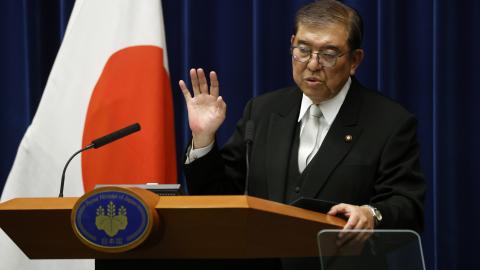Timeline and Analysis
August 14: Prime Minister Fumio Kishida announces he is stepping down.
September 27: The Liberal Democratic Party (LDP) holds a presidential election to determine the party’s new leader. Shigeru Ishiba wins with 215 votes. Ishiba forms a new government and announces a dissolution of the lower house.
October 27: Japan holds a lower house election. The LDP-Komeito coalition falls short of a 233-seat majority, holding only 215 of 465 seats.
November 11: The Diet holds a special session to elect Japan’s next prime minister. No candidate wins a majority in the first round of voting. Ishiba wins a runoff against Yoshihiko Noda of the Constitutional Democratic Party (CDP). A second Ishiba administration is formed.
Prime Minister Shigeru Ishiba’s rocky start may affect Japan’s relationship with the United States. President-elect Donald Trump’s push to have Asian countries, like Japan, increase defense spending may create tension between the two leaders. If Ishiba’s LDP had kept its majority in the lower house, the party would have likely continued increasing Japan’s contributions to regional defense, which may have been more beneficial for the US-Japan relationship. Now, Ishiba and Trump will have to figure out how to advance their nations’ ties amid a more uncertain political landscape.
Ishiba Wins Runoff, Forms Second Administration
The Japanese Diet reelected Shigeru Ishiba of the LDP as Japan’s prime minister during a special session on November 11. Just two weeks prior, the LDP lost its majority in a lower house election. Still, Ishiba was able to secure the plurality of votes needed to stay in office.
Ishiba’s win assures some continuity for Japan, as the LDP will maintain its longstanding control over the government. But Ishiba will have to work with new parties to be able to pass legislation, resolutions, and a budget.
For the first time in 30 years, the Diet required a runoff to determine Japan’s prime minister. Neither Ishiba nor Yoshihiko Noda, the leader of the CDP, won a majority in the first round of voting. The runoff produced 221 votes for Ishiba, 160 votes for Noda, and 84 invalid votes.
Following the runoff, the second Ishiba administration was enacted, and the prime minister began to form a new cabinet. Compared to his first cabinet, Ishiba replaced only the minister of justice and the minister of agriculture, forestry, and fisheries. He also announced that a member of the LDP’s coalition partner, the Komeito, will be minister of land, infrastructure, and transportation.
The LDP’s Electoral Struggles Continue
In the late October lower house election, the CDP won 148 of 465 seats. The LDP-Komeito coalition won 215 seats, losing its majority. This forced the LDP to expand its coalition to secure enough votes to confirm Ishiba as prime minister. He chose to reach out to Yuichiro Tamaki, the leader of the Democratic Party for the People (DPFP). The CDP also reached out to the DPFP to form a coalition. But the DPFP rejected both offers. The ruling coalition gained just six votes as LDP members who ran as individuals during the lower house election rejoined the party.
It has been a rocky month for Ishiba and the LDP. The LDP was not able to add any partners to its coalition to secure the confirmation votes and will likely struggle to pass any new policies without a majority. Disagreements over topics like defense budgets, constitutional changes, and taxes will affect the LDP’s ability to advance its vision for the country. This adds significance to the next major election in Japan, an upper house election in July 2025.





















